Self-propelled modular transporter (SPMT) are used to transport heavy cargo, which in most case is more than a hundred tons. The special vehicles are also widely used to carry over length goods that other heavy haulers cannot transport.
In this guidebook, you will learn about the self-propelled modular transporter (SPMT) and we will learn what is a hydraulic modular trailer in next guide.
Part 2: Modular Trailer Ultimate Guide – Learn Modular Trailers Specs & Designs
For each of these models, the guidebook outlines its specification, different structures, and different steering models.
In these two guide book, you will learn how to keep the heavy-duty modular trailers stable when transporting heavy goods. The book outlines the differences between the two modular transporters.
It provides a buying guide to help you select the right supplier in China, which is one of the leading markets of modular transporters.
Two guides will cover the two modular transporters. Illustrations of different parts are used to enhance your learning of the transporters.
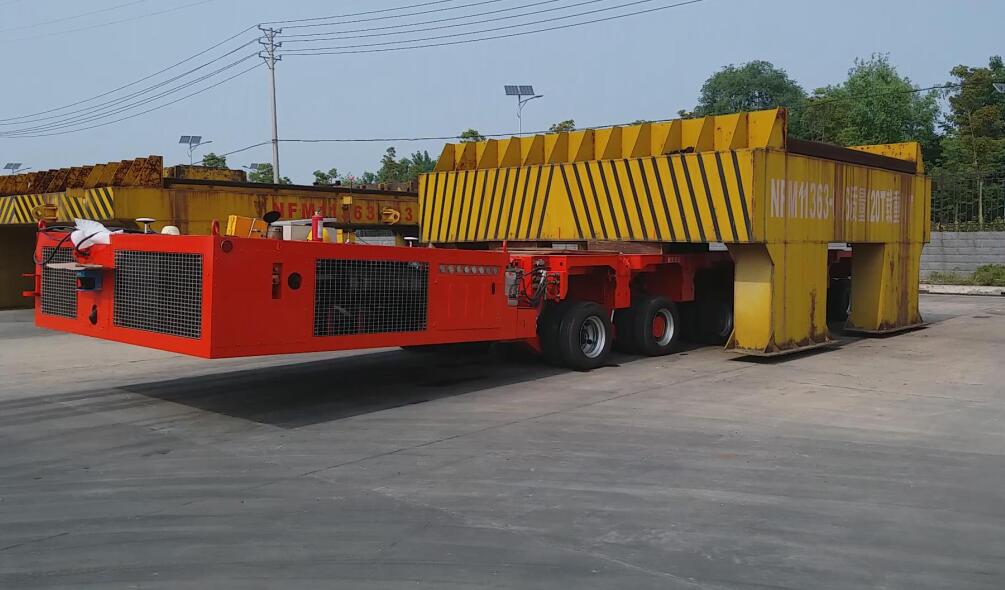
SPMT
Table of Contents
Chapter One: What Is SPMT?
A self-propelled modular transporter is a special vehicle that has three major functions including hydraulic driving, hydraulic steering, and hydraulic lifting. A hydraulic system is used to drive each of these functions. The transporter is used for the transportation of heavy loads such as sections of a ship, the whole ship or a prefabricated section. The special vehicles transport such cargo from a shipyard to offshore sites. Other heavy haulers cannot transport such cargo because of its weight and length. An SPMT can drive the cradle that bears heavy loads, use its hydraulic lifting system to lift up heavy loads, and then transport the loads to the right destination. The transporter does not any hoisting equipment or a crane for the functions. Most of other heavy haulers require additional hoisting equipment to load cargo on their platform. One person can control all the functions until the load reaches its designated place.
1.1 Applications of SPMT
SPMTs are used in different industries because they can transport all types of goods. The major industries where these transporters are used are outlined below:
Shipbuilding industry: Ships are assembled in shipyards before they are transported to the shore. In most cases, the shipyards are located miles away from the sea shores.
SPMTs are used to transport sections of a ship or the whole from the shipyard to their designated place. Ships are part of the heaviest loads that are transported on the road.
The modular transporters have enough capacity and space to accommodate such heavy and bulky cargo.
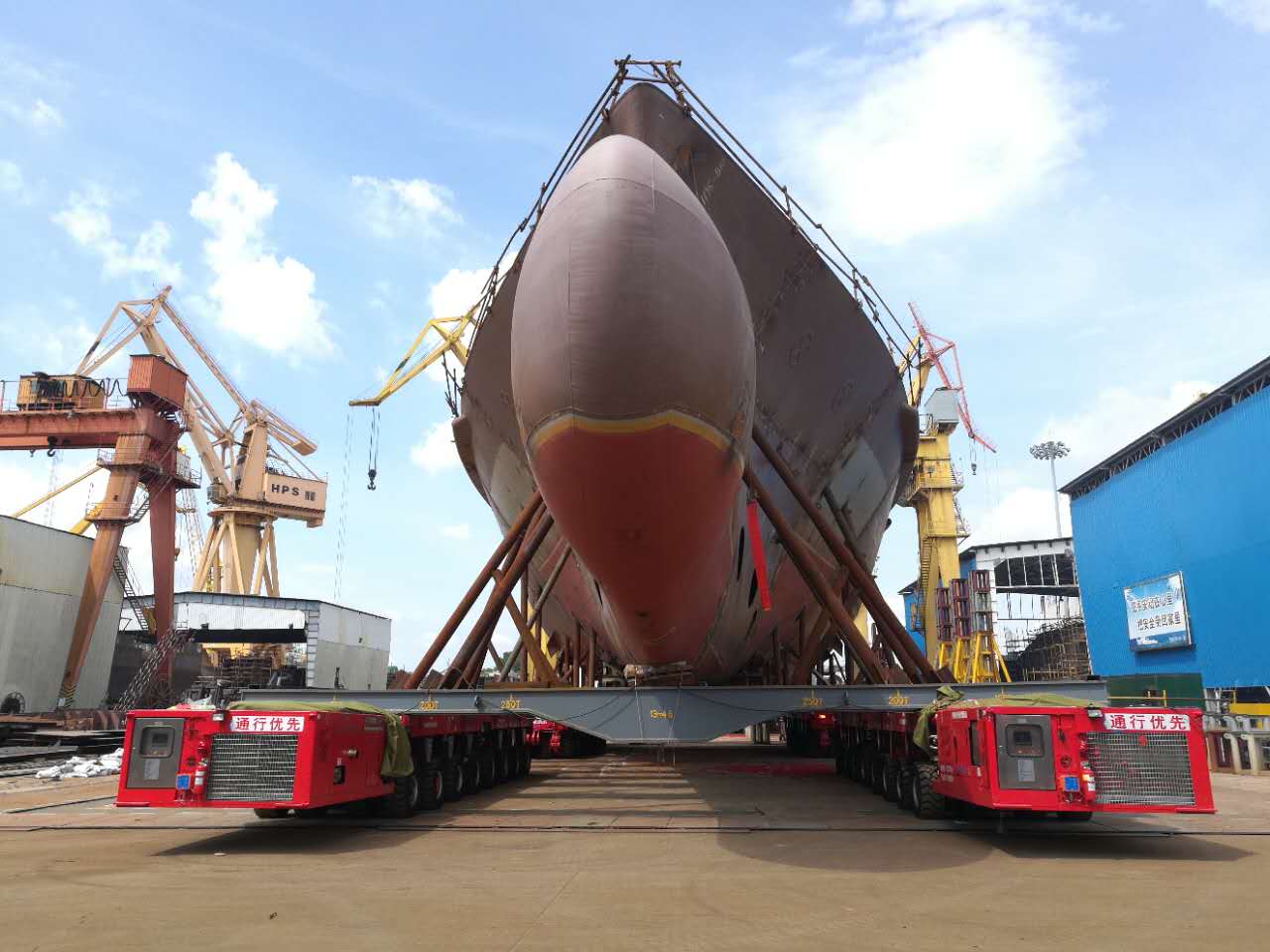
spmt for shipbuilding
Oceanographic engineering: Oceanographic instruments, equipment, and devices are also assembled off-site and then transported to the sea using SPMTs. The ocean environment does not support the manufacturer and repair of equipment.
The functions must be done in an assembly unit on land before the equipment can be moved to the right destination. The modular transporters provide a convenient way for the manufacturers to move the equipment to the seashore.
Heavy-cargo logistics: Some companies specialize in transporting heavy cargo from one destination to another. Such companies serve clients who need to transport heavy loads a few times in a year.
For instance, a new manufacturer may need to transport the production equipment to the warehouse. Logistics companies require SPMTs to transport such types of loads.
The heavy cargo in this case ranges from machinery and equipment to stacks of finished products or raw materials. The modular transporters can be customized to transport any cargo as long as it is well packaged.
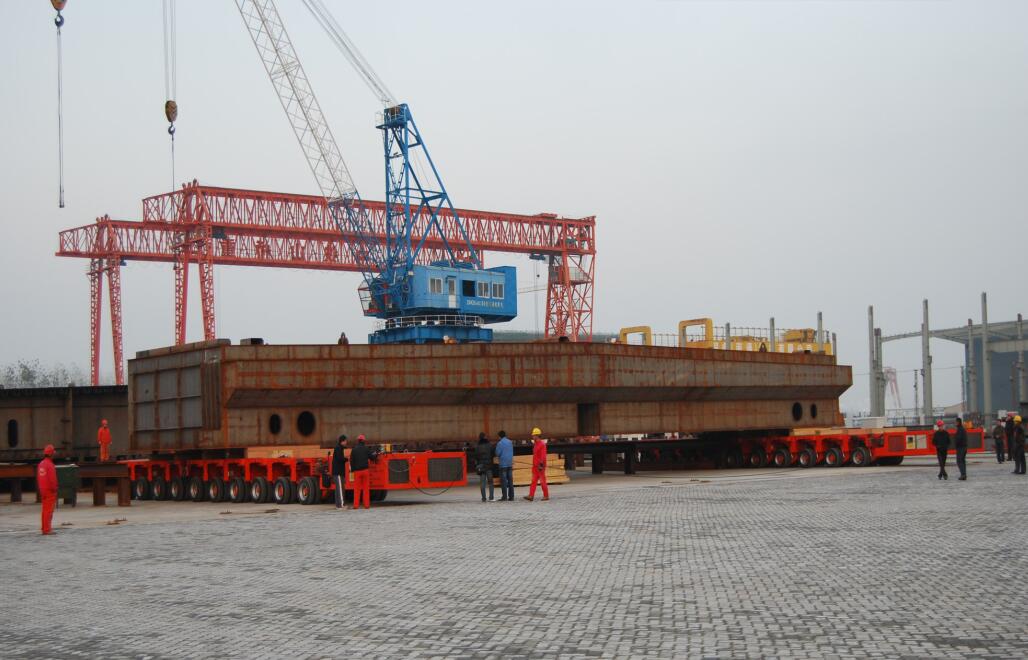
spmt for heavy cargo
Heavy equipment manufacturing: Heavy equipment manufacturers require transport solutions to transport components to their assembly units. Some of the parts include long and wide metallic beams depending on the final products.
The manufacturers also require transport solutions to transport the fully-assembled equipment to the clients or warehouse. Self-propelled modular trailers are the best transport solutions for heavy equipment.
The modular transporters provide a reliable solution for all companies that use heavy and bulky equipment in their production processes.
Electric power construction: The companies involved in constructing power plants use heavy machinery and equipment to set the plants. Large power plants use the heaviest parts because of the capacity required.
The companies rely on modular transporters to move their construction equipment and heavy component to the power plants. Power plants are mostly made of large and heavy steel beams.
Chemical industry construction: The chemical industry also requires special transportation vehicle to move heavy raw materials, equipment, and finished products.
Setting up the manufacturing sites requires the companies to transport heavy and long tubes, cylindrical tanks, and metallic beams among other parts.
In most cases, the parts are purchases from other assembly companies and transported to the chemical production sites.

chemical tank transport
Project construction: SPMTs are commonly used to transport construction blocks include concrete blocks to construction sites. Concrete bridge and road sections are safely transported using these heavy transporters.
The modular transporters are also used to ferry construction materials in bulk such as cement, ballast, and sand among others.
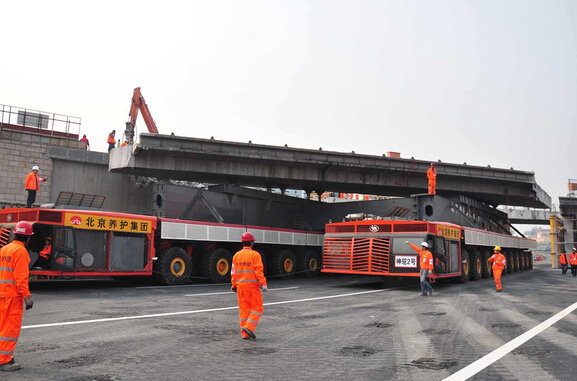
Project construction
Heavy equipment transport: Every company that uses heavy equipment in its production process requires a special vehicle to move the equipment from the manufacturer to its warehouse.
Some companies deal in buying and selling heavy equipment. SPMTs offer great solutions to such companies.
We have outlined the most common applications of self-propelled modular trailers. However, their applications are not limited to these industries.
The heavy-duty hauler can move any heavy load from one place to another as long as the cargo is properly packaged. Let us now look at the specifications and structure that enables the transporters to carry the heaviest industrial loads.
Read more:
Best SPMT Manufacturers You Should Know
Introduction to SPMT Bridge Moves
How to Replace a Bridge in Only 22 Minutes By SPMT (Self-propelled modular transporter)
Chapter Two: The Specifications of SPMTs
SPMTs have two major specifications, which determine their performance and cost. The first specification is the SPMT with a width of 2.43m while the second has a width of 3m.
The first type with the width of 2.43m is the most commonly used SPMT in the world. One of the reasons why this type is preferred is that it is easy to load it into the container.
In addition, it easier to transport by sea than it is for the second type. The main shortcoming is that it is more expensive than the second specification.
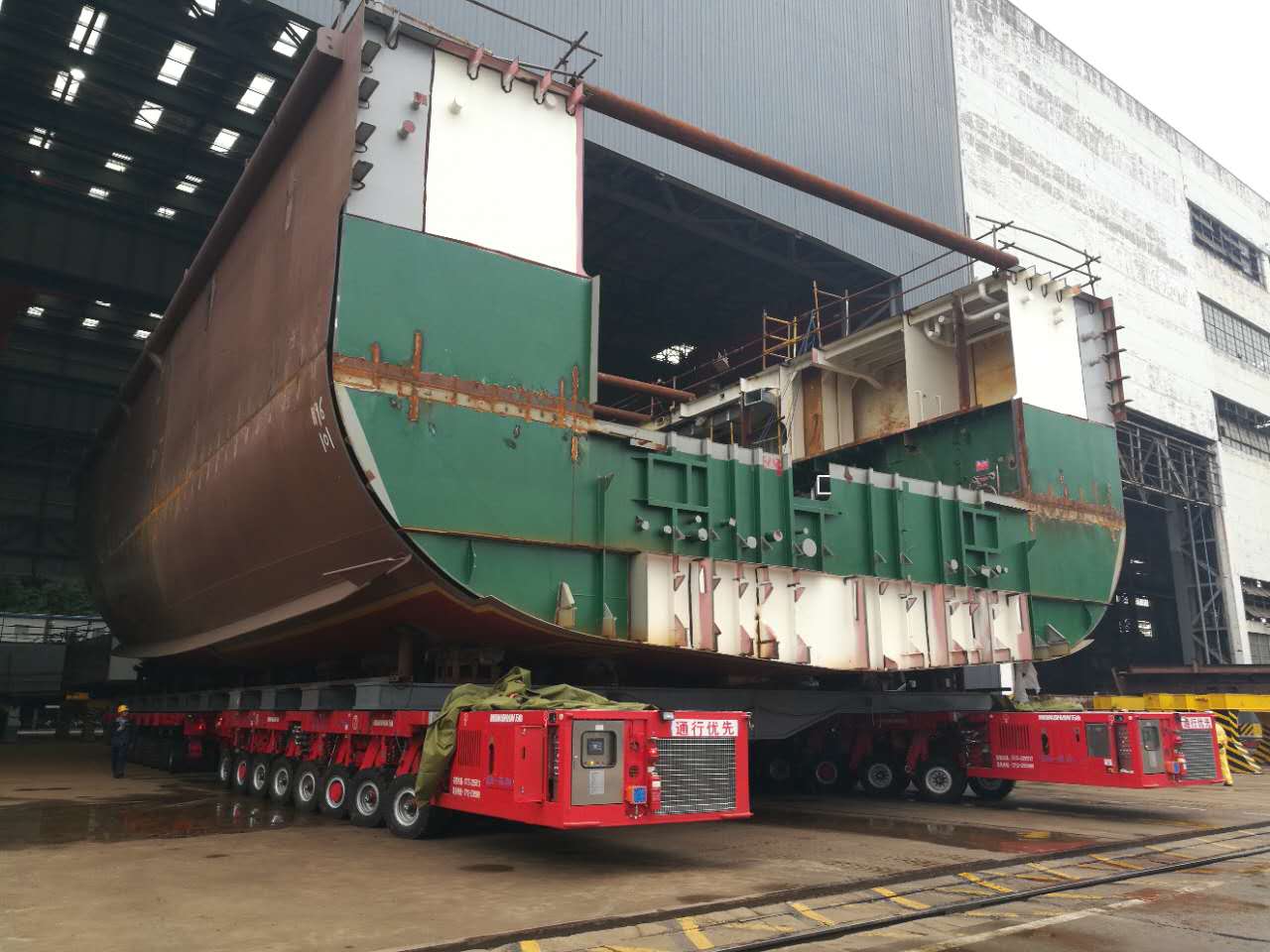
2.43m spmt
The 3m type is cheaper than the 2.43m type but it less popular in the market. The type has a higher cost performance than the first type. The height of SPMT ranges from 1150m to 1850m.
The two specifications have different loading capacities. The 3m type has a maximum load capacity of 36 tons per axle. The 2.43m model, on the other hand, has a maximum capacity of 40 to 48 tons per axle.
The loading capacity of the 2.43m is higher and hence the trailers are more expensive
3m Models

3 m model spmt specifications
2.43m Models
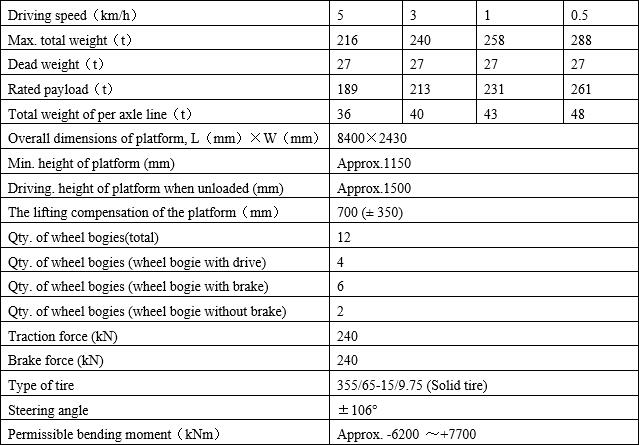
2.43 m model spmt specifications
Contact us, get more specs now!!
Reference:
What is SPMT (self-propelled modular transporter)?
Chapter Three: Parts of the Main Equipment
In this chapter, we will look at the main components of a self-propelled modular transporter. The main components include the power pack unit, frame, hydraulic system, and the hydraulic suspension. The transporter also comes with additional accessories that enable users to modify its structure. The type of additional accessories depends on the model of the transporter. We will also discuss how to keep the transporter horizontal when carrying heavy loads in the chapter.
3.1 Power Pack Unit
The power pack unit (PPU) in a self-propelled modular transporter consists of a diesel engine, radiator, variable pump, transfer case, and an air filter.
Other components of the PPU include an intercooler, hydraulic oil tank, hydraulic oil cooler, micro-control system, storage battery, and a fuel tank among other components.
The PPU has a lifting cylinder, which is used to lift the power pack unit to the same height as that of the platform. The PPU can also be lifted with the same mechanism to 12° to adapt to a slope.
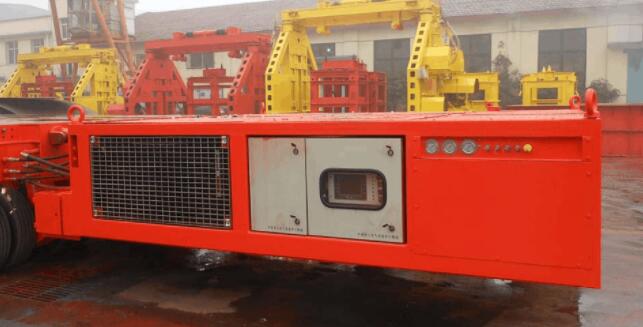
spmt ppu
3.2 Frame
The frame is the main component of the transporter that bears the weight of the load. The security coefficient of the design is 1.5 because the frame bears the most dangerous condition of the load.
The main bearing parts in a trailer including the wheel bogie and the main girder of the frame have a firm box-type beam structure.
The materials used to make the bearing parts are high-performance welding plates with a yielding strength of 690MPa.
The whole frame of the modular unit has high strength and a great ability to resist any force that may cause it to bend. The properties of frame prevent the problem of concentrated loading.
The frame has a longitudinal beam in the middle, which has a trapezoidal box structure. It also consists of oscillating cylinders cases that are welded into the frame as one unit.
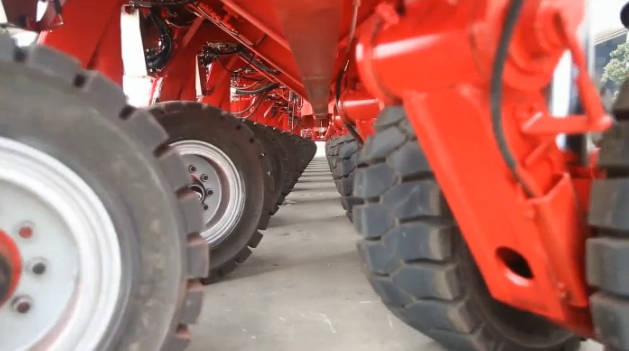
spmt frame
The middle section of the frame has three pin holes in the chips shape located towards the end of the frame.
The purpose of the pin holes is to enable end-to-end coupling, which is common with self-propelled modular trailers. Both sides of the frame have bolt holes that enable side-to-side coupling.
The frame also has four hook points that are located near the four corners. The function of hook points is to bear the dead weight of the modular transporter for hoisting.
3.3 Hydraulic System
The hydraulic system consists of five major parts with different specifications and functions.
The parts include the hydraulic brake system, hydraulic cooling system, hydraulic lifting system, hydrostatic drive system, and hydraulic steering system. Each of these systems is discussed below.
- The hydrostatic drive system
The system refers to a closed-loop hydraulic system with a variable drive pump. The control type of the variable pump is an electric proportional control (EP).
The drive systems uses pressurise liquid to power the modular trailer. The term hydrostatic, in this case, refers to the transfer of energy or power from flow and pressure. The term does not include the kinetic energy of the liquid flow.
- The hydraulic steering system
This system is an open-loop system with an open-loop variable pump. The pump has two major functions that include loading sensing and controlling pressure-cutting-off flow.
It can adjust the output flow of the variable pump based the needs of the load. Adjusting the flow also saves energy. The pressure-cutting-off flow control function enables the operator to restrict the variable pump’s maximum output pressure.
The main reason for restricting the pressure is to protect the hydraulic system from potential damages.
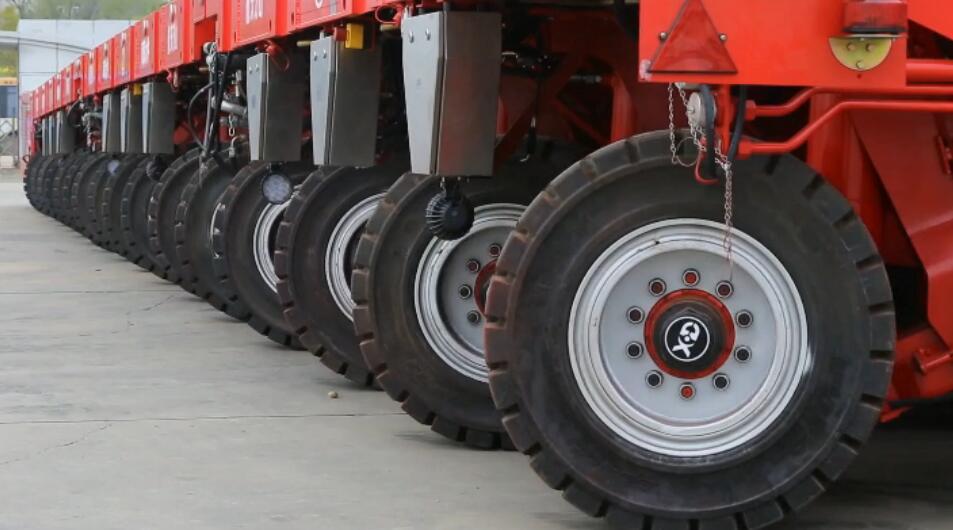
spmt steering
- The hydraulic lifting system
The hydraulic lifting and steering system share the same open-loop variable pump. The hydraulic oil from the variable pump is shared equally between the lifting and steering cylinder.
Consequently, the platform of the modular transporter lifts evenly and remains horizontal when lifting.
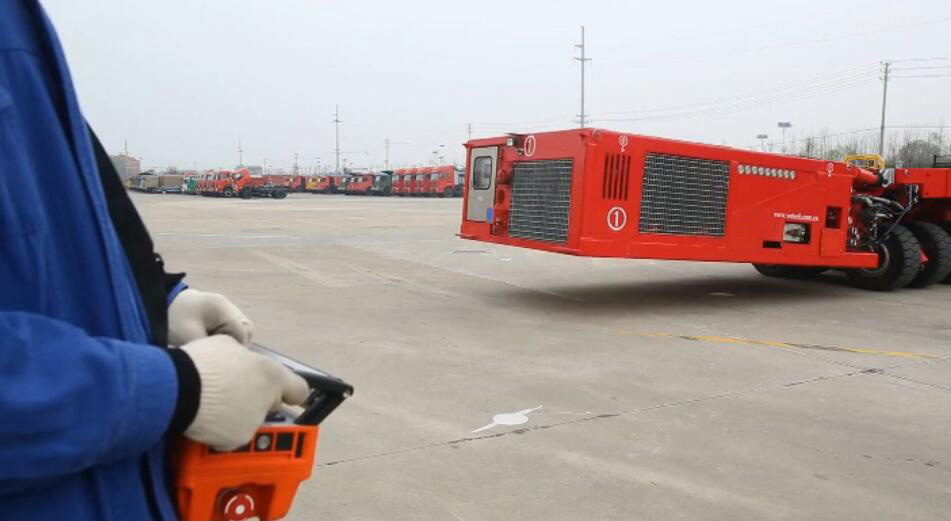
spmt control
- The hydraulic cooling system
The cooling system consists of two gear motors that drive fans that cool the composite radiator. One gear pump is used to supply the hydraulic oil under great pressure to the two gear motors.
- The hydraulic brake system
The brake system in a modular transporter and its parking brake work when the hydraulic brake cylinder is pushed and the brake drum released.
The brake cylinder has springs that keep the transporter in the parking brake state when the cylinder has no pressure oil. The braking system has a manual pump, which is used to release the parking brake when there is no power in the vehicle.
- The hydraulic suspension
The hydraulic suspensions are divided into different wheel bogies. The bogies include wheel bogies with brake, wheel bogies with drive, and wheel bogies without brake.
The hydraulic suspensions consist of a hydraulic suspension cylinder, bogie frame, axle with drive, axle with brake or without brake, rocker arm, and tire.
The gear shaft sleeves are usually welded onto the bogie frame and a hydraulic suspension cylinder placed between the rocker arm and bogie frame.
The purpose of this cylinder is to connect the two parts and bear the load, which gives the hydraulic suspension system an adjusting range of ±350 mm.
The motor and reducer are installed on the wheel bogies with drive to provide the driving force for the modular transporter. The wheel bogies with brake are usually installed together with the axle with brake that has a brake cylinder on it.
The cylinder has the parking and service brake for the vehicle.
The three different types of wheel bogies used in the transporter have a mechanical stopper that limits the maximum position. The stopper uses the minimum stroke of the hydraulic suspension cylinder in order to control the lowest position.

drive axle
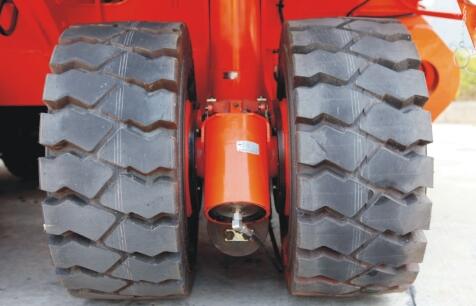
brake axle
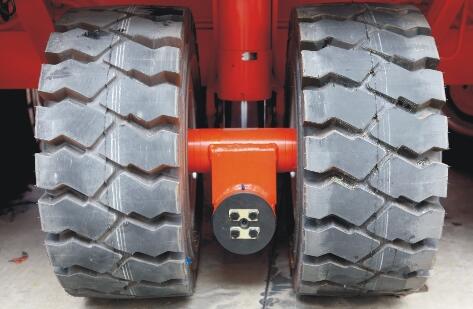
support axle
A pin is used to lock the lowest position of the hydraulic suspension cylinder. The locking pin is also used for transporting vehicles, repairing the axles and replacing tires.
When replacing tires of a fully loaded or unloaded modular transporter, the transporter is brought down to its lowest level. The locking pin is then placed into the wheel bogie for the tire that needs to be replaced.
The next step is to shut off the ball valve in the suspension cylinder and lift the transporter up for the tire to be replaced.
After replacing the tire, the transporter is lowered down again to its lowest position. The locking pin is removed and the ball valve is opened. The transporter is then lifted up back to its driving height.
The hydraulic suspension system helps in keeping the self-propelled modular transporter horizontal when transporting heavy loads.
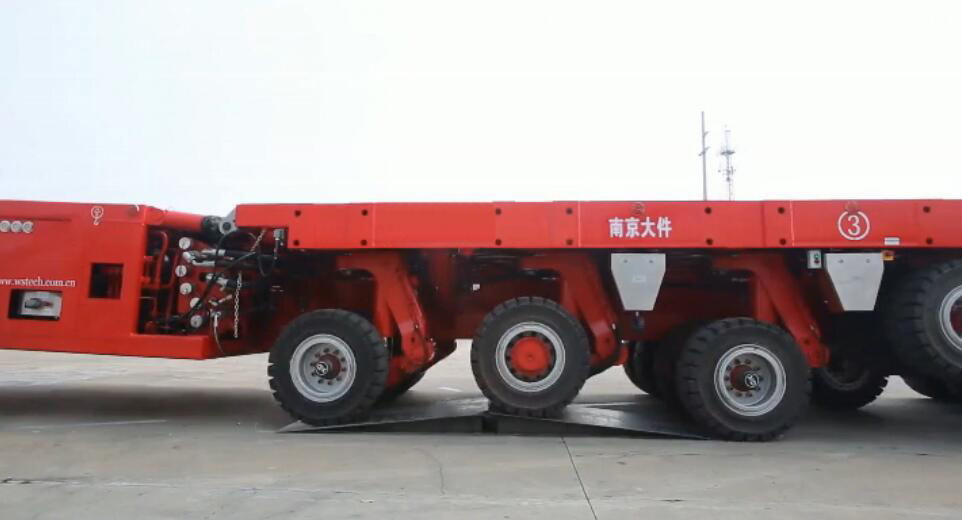
keep horizontal
The suspension system can be adjusted to different positions such that the support system of the transporter has three or four points of support. The different points of support bring an equal distribution of the load on the tires.
In addition, the supporting points make the transportation of heavy loads on uneven or rough roads safe and reliable.
suspension cylinders in the transporters are installed with two directions anti-break valve.
When the pipeline is broken, the increasing flow creates a differential pressure between the inlet port and outlet port of the valve to block the broken pipeline. This prevents the cargo or load from inclining on one side.
Consequently, the modular transporter remains stable while transporting heavy loads.
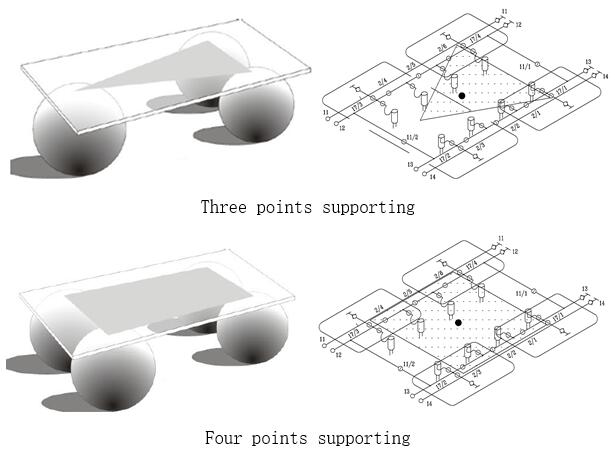
spmt support
Each wheel bogie with drive on the modular trailer has a speed sensor. The micro-electric system monitors the driving wheels’ sleep slip ratio constantly when the self-propelled transporter is moving.
If the sleep slip ratio of any of the wheels goes above the setting value, the micro-electric system sends a signal immediately.
The signal causes changes in the displacement of the driving motor, which ensure that other wheels with drive have the normal tractive force.
The modular transporter achieves anti-skid control and protects its motor through the function of the micro-electric system.
Skidding is dangerous for the heavy haulers because it may lead to loss of lives, cargo, and damages to the trailer, especially if the vehicle overturns.
3.4 Remote Controller
A self-propelled modular transporter has a radio remote controller that integrates all the buttons and switches that control the operations of the transporter.
The radio remote controller has two major components that include the receiver and the emitter. The controller can transmit data through a cable.
In case there interruptions in transmitting remote signals in the working environment, the controllers immediately starts using the cable to transmit data. The cable controller functions in the same way as the radio remote controller.
The radio remote controller can achieve the set of the master or slave coupling of the modular transporter. The controller of the master transporter can achieve all the functions of the modular combination.
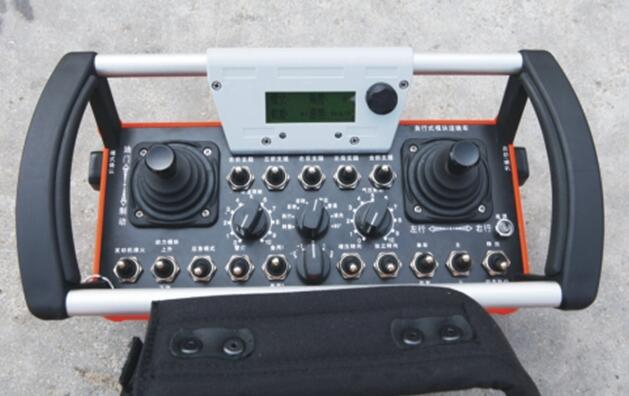
remote control
A single modular transporter has the same functions that include acceleration, braking, monitoring information, driving forward and backward, and normal driving.
Other functions of a modular combination include the setting of steering modes, pressing the parking brake, stopping the engine, steering to the left or right, and stopping for emergencies.
The remote controller comes with straps that improve fastening. The remote controller enables one operator to load a modular transporter without any hoisting or lifting equipment.
3.5 Electronic Control System
The electronic control system has an extended module and an electronic calculating unit. A modular transporter uses a rated voltage of 24V to equip two pieces of 180AH or 165AH depending on the model.
The electronic control and monitoring equipment that are installed on the PPU have an LCD color monitor. The main functions of the meter display include monitoring and general operation functions.
Other functions include meter display of the oil pressure of the engine, air pressure of the brake, and the hydraulic steering pressure.
The meter display also shows the driving speed, fuel level of the engine, working hour of the engine, water temperature of the engine, and the hydrostatic driving pressure.
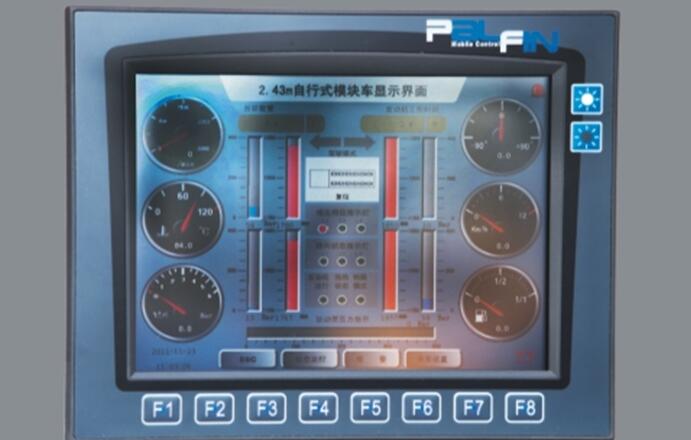
main display
The lighting alarm shows the blockage of engine filters, the abnormal temperature of the engine cooling material, abnormal pressure of the engine lubrication oil and the blockage of hydraulic filters.
The lighting alarm also displays the low level of hydraulic oil, the low level of fuel, and the low level of hydraulic oil.
The control components in the control boxes and wire markings or terminals are reliable and firms.
The main electronic components including the LCD display, pressure sensor, angular sensor, and the electronic calculating unit have a high protection class.
The lighting components include the tail lamp device and the emergency lamp warning device.
3.6 Combination coupling for SPMTs
There are two major methods of coupling modular transporters, which include side-by-side and end-by-end coupling. The method of coupling that a transporter chooses depends on the dimensions of the cargo.
Side by side coupling is necessary for wide cargo while end by end coupling is used for over length cargo. The modular transporters can either use mechanical coupling or loose coupling.
A hydraulic pin and a special connecting pin are used for coupling transporters end-by-end. The side-by-side coupling uses specific devices or communication cables that are designed to ensure safe coupling.
Each modular transporter has a control system that helps it to achieve a coordinated and synchronized steering function as well as other functions.
When different modular transporters are coupled, they communicate through the CAN bus, which makes the coupling combination to work in a coordinated and synchronized manner.
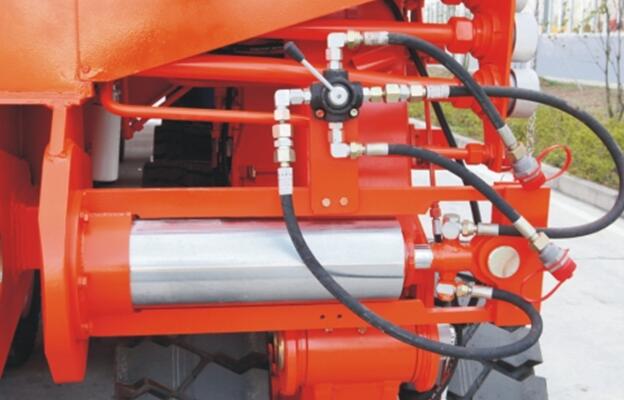
spmt connection part
When several modular transporters are communicating or transmitting data across each other, each transporter is referred to as a master unit.
The other modular transporters get driving, steering, lifting and braking instructions from the master electronic calculating unit.
The combination between the coupled transporters and the combination between the modular transporter and the PPU use a hydraulic pipe, mechanical device, and a cable.
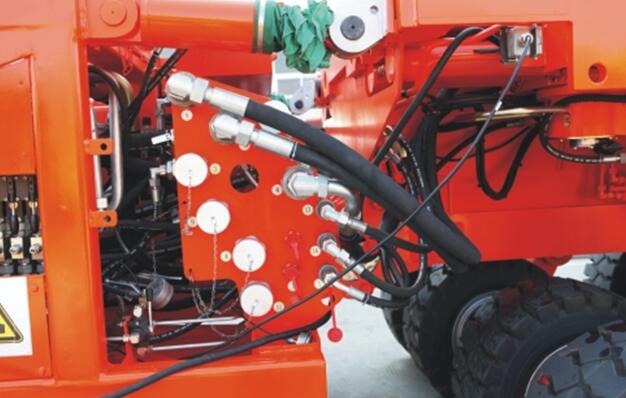
spmt connection pipeline
The combination of the hydraulic lines and cables use hydraulic fast couplings and reliable electric connectors. The devices have an error-proof design that ensures a safe and reliable coupling.
Safe coupling is important to ensure that heavy cargo reaches its destination in a good condition.
3.7 Compound Mode
Self propelled modular trailers use different combinations to transport over size equipment or any other cargo.
The ability to use different combinations include the 4-fold combination, T combination, V combination and circle combination make the SPMT economical and efficient.
You do not need to order for a customized special transporter for a project. The same SPMT can handle different projects and transport all types of heavy cargo.
You just need to change the combinations to suit the dimensions of the cargo.

spmt combinations
If the SPMT’s length is not enough to accommodate the full load, the frame is used to increase the transporter’s length.
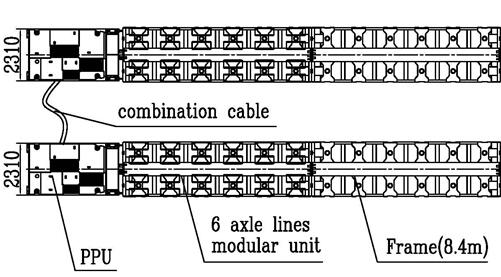
spmt frame
Chapter Four: Different steering structures in SPMTs
Self-propelled modular trailers have two major types of steering systems. The two systems are the electronic compound multi-mode steering system and a mechanical steering system. Let us look at the functionality of each system.
4.1 Electronic compound multi-code steering system
The steering system consists of several parts including the steering hydraulic pump, oscillating cylinder, angular sensor, and a proportional sandwich valve.
Other parts in the system include rack-and-pinion steering device and an electronic calculating unit. The rack-and-pinion steering device consists of the oscillating cylinder cases, pinion, rack, oscillating cylinder, and angular sensor.
The function of the cases of the oscillating cylinder is acting as a cross girder.
The cases are welded together with the frame into one unit that has a reliable structure and great manufacturability. The angular sensors are usually installed on the wheel bogies.
Each bogie has its angular sensor. When a steering signal is released from the remote controller, the electronic calculating unit calculates its theoretical angle based on the steering mode.
The electronic unit will then compare the feedback from all angular sensors on all wheel bogies.
The comparison of feedback gives the electric current of the proportional sandwich valves that control opening. The hydraulic steering cylinder will then push the wheel bogies such that they steer to the right positions.
A self-propelled modular transporter can assume 8 different steering modes. The steering modes include:
- All wheel steering along mode
- Diagonal steering cross mode
- Reset mode
- All wheel steering cross mode
- Rear wheel steering mode
- Circle steering mode
- Diagonal steering cross mode
- Front wheel steering mode

single transporter steering
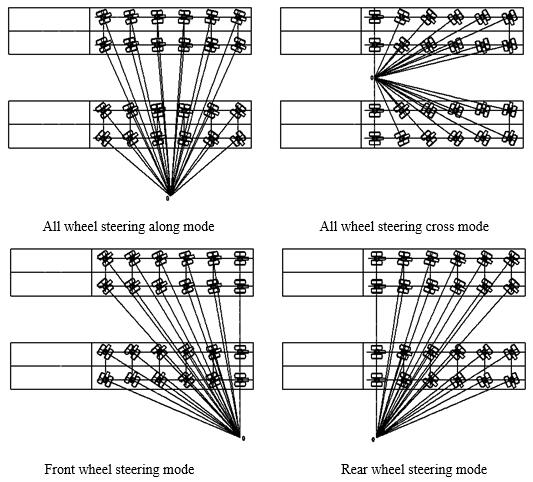
double transporters steering 1
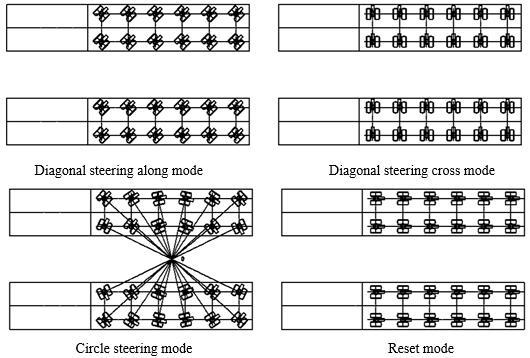
double transporters steering 2
The multi-coupling transporters have the same steering modes as the single transporters. Whenever the difference in the steering angle of the wheel bogie is above 8°, the driving system of the transporter shuts automatically.
Consequently, the vehicle stops or gives an alarm.
A SPMT can also assume other steering modes depending on the requirements of the operation. The electronic compound multi-mode steering system can achieve ±110°angle steering.
Here are three types of steering transmission used in electronic compound multi-code steering system:

pinion and rack

worm and gear
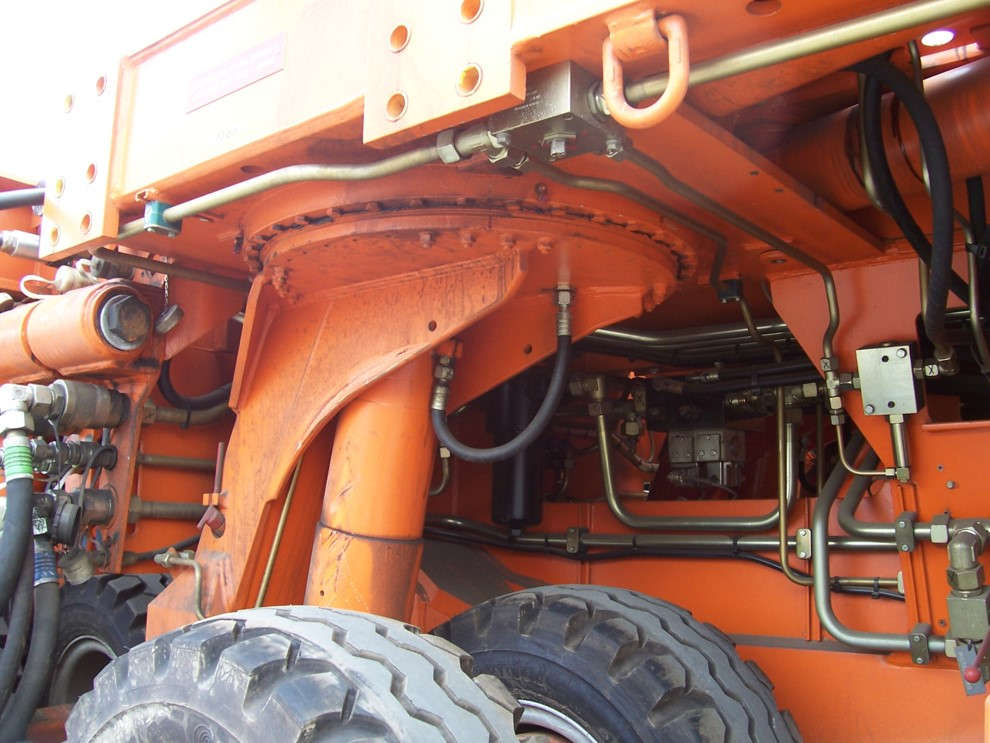
cylinder transmission
4.2 Mechanical steering system
The mechanical steering system is limited in that it can only achieve ±55° steering angle. The SPMTs and modular transporters use the same mechanical steering system.
Hence, the mechanical steering system will be discussed in details in part two, chapter 3.3. A few things to note about the mechanical steering system are that it has four major components.
Part 2: Modular Trailer Ultimate Guide – Learn Modular Trailers Specs & Designs
The components include a steering orifice plate, a steering central panel, steering cylinders, and steering rods.
The steering orifice plate is welded with the bogie frame. It has specific quantities of assembling holes that are used for installing steering rods.
Read More:
Self-propelled modular transporter
Chapter Five: Designs of the SPMT
Self-propelled modular transporters have different structures, which in most cases vary depending on the number of axle lines. It is easier to understand the structures when looking at diagrams with different components. In this chapter, we will provide several diagrams of different structures of SPMT. Remember that SPMTs are either 2.43m or 3m in width. You will view diagrams of both 4-axle and 6-axle structure of both types of SPMTs.
5.1 Drawings of SPMT
The diagrams of different structures of SPMT have dimensions indicated on some components. The diagrams also have a key to help you determine where the drive pendulum axle and brake pendulum axle are located on the each structure.
Structure diagram of 2.43 m SPMT model with 4 axles
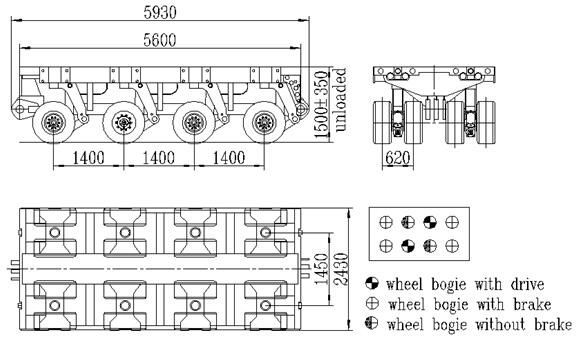
4 axles spmt
Structure diagram of 2.43 m SPMT model with 6 axles

6 axles spmt
Structure diagram of PPU

spmt ppu
Structure diagram of SPMT Project
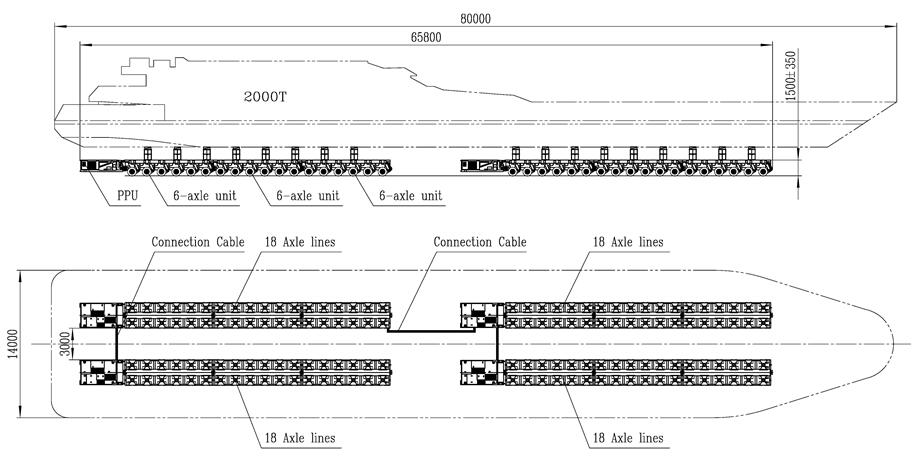
project drawing
Contact us, get more drawings now!!
Chapter Six: Modular Transporter Forecast
China is one of the leading suppliers of SPMT and modular trailers in the world. Despite the quality concerns that many people on the goods manufactured from China, the country continues to lead in supplying heavy-duty vehicles. The reality is that the manufacturers produce goods for all categories of markets. Some vehicles are assembled for the low-end market while some are designed for the high-end market. In fact, some manufacturers in China assemble heavy-duty vehicles for some of the top suppliers in foreign countries.
You can order for a high-quality, sturdy, and long-lasting SPMT and modular trailers from the country. However, you must choose the right supplier to get the right product. In this chapter, you will learn how to choose the right supplier for a modular transporter. You will also learn how the state of modular transporters in China.
6.1 How To Choose A Good Manufacturer In China
China has so many suppliers of modular transporters that claim to provide the best transporters in the world. If you do a quick online search, you will find many advertised module trailer and SPMT.
Buyers are sometimes confused in selecting the suppliers because the specifications of the vehicle seem similar. Buying a modular transporter is an expensive good to buy.
You do not want to take the risk of buying the wrong model or a low standard vehicle. Below is a guide on how to select a good supplier in China. The guide shows the most important aspects to consider when selecting the suppliers.
- Quality
The quality of a product is one of the top considerations when choosing a supplier. The best supplier of a modular transporter should guarantee you of high quality vehicles. You will find claims from all suppliers that their vehicles are a high quality. Hence, you must go beyond the advertising messages and check the production processes. If a supplier is certified, you are likely to get a high quality modular transporter.
Another way to check the quality is to ask about the manufacturing processes. High-welding performance is required for the components of modular transporter to be strong enough. Poor manufacturers will hasten the welding processes to finish the products fast. Go for a supplier that follows the right manufacturing procedures. Do not forget to check reviews and recommendations from other customers who have already bought module transporters from the same suppliers.
The good thing about purchasing a product like a module transporter is that you can inspect the components before buying. Inspect all the components include the quality of steel used and welding. Compare the same model of a transporter from different suppliers before making your final decision.
- Factory strength
Another important consideration to make when choosing a supplier is the supplier’s factory strength. The quality of components that the supplier uses in the modular transporters depends on the factory strength. Take time to investigate the nature of factory or assembly unit that the supplier operates. Some suppliers are not directly involved in assembling module transporters. Instead, the buy the transporters from manufacturers and resell them to buyers at a profit.
One of the important lessons you can learn when comparing suppliers from China is to identify that actually manufacturer their products. Try to ask questions about the manufacturing process and check their level of knowledge on the same. Some suppliers will be direct and inform you that they do not have the technology to assemble modular transporters. Others will give the impressions of a well-equipped factory. Visit the factory where possible and have a first-hand experience of the manufacturing process.
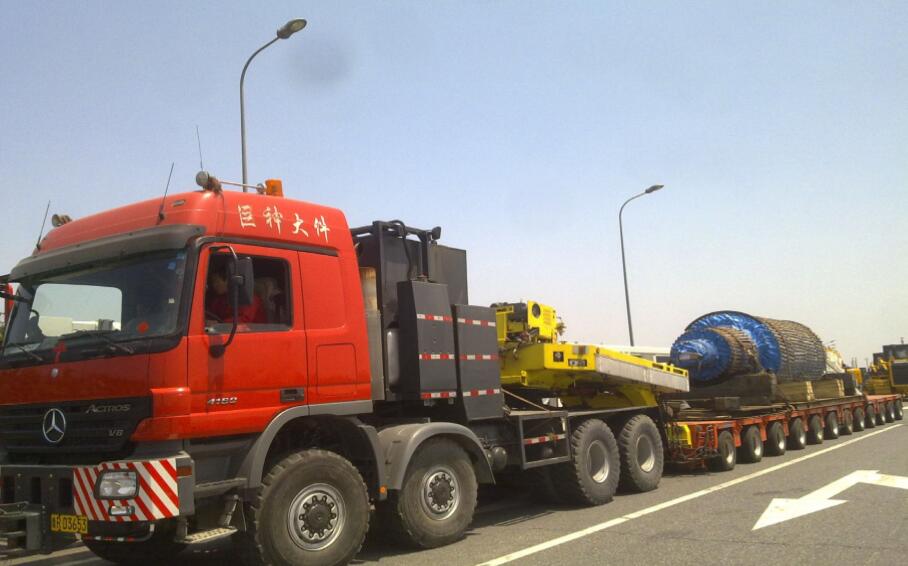
heavy duty transporter
- Service
You can determine if you are dealing with the right or wrong suppliers based on their quality of customer service. Buying a modular transporter is a sensitive process that involves constant communication and negotiations with suppliers. You do not want to spend huge amounts of money on the wrong transporter. The supplier should be willing to answer all your questions, especially concerning the specifications of different models. Avoid suppliers with rude and unprofessional customer care representatives.
The right suppliers hire competent people to work in the customer care team. If you cannot reach the supplier on the provided communication lines, you need to look for another supplier. You also need to consider an alternative supplier if it takes a long time to get a response from the suppliers. The delays in communication or giving feedback may be an indication that the supplier is not directly involved in manufacturing the modular transporter. The staff has to consult the real manufacturer before addressing your questions.
- Technology
The type of technology that a manufacturer uses in the production process influences the quality of the final product. The best manufacturers invest in the latest technology to assemble modular transporter. You can expect a safe, reliable, durable, and sturdy modular transporter from a manufacturer that uses the best technology. This requires research to certify that indeed the supplier has the technology in the factory. Remember that suppliers use all types of marketing tactics to advertise their products.
If you can visit the factory and inspect the technology, you can make an informed decision. However, this is not always possible for all buyers. The supplier’s website and other online platform can give you some clues on the technology in the factory. Another reliable source of information on technology is the previous buyers that have visited the assembly unit. Always go for a supplier that continually upgrades production technology. The good thing about buying from China is that most manufacturers are quick to adopt advanced technology because of the stiff competition.
- Price
Start the purchase process by defining your budget for the module transporter. Consider the amount that your business can easily pay for the transporter without affecting the cash flow. Once you set your budget, compare prices of the same model of modular transporter from different suppliers. Remember that both SPMTs and hydraulic modular transporters come in different structures as described in the previous chapters. The prices vary depending on the specifications. Hence, you must compare the specifications when comparing the prices.
The purpose of comparing prices is to identify the supplier with the fairest prices in the market. However, do not settle for low quality transporters to save on costs. The buying price is not the only cost that you incur when you buy a heavy-duty vehicle. Consider the cost of maintaining the transporter in a good working condition. If you buy a cheap modular transporter, you are likely to spend a high amount on maintenance. The components of such a vehicle have a short life span.
A modular transporter may be expensive upfront but its maintenance cost will be low if the supplier uses high-quality materials. This does not mean that all expensive transporters are of good quality. Some suppliers offer their products at high prices even if the quality is average. Remember that you have a budget to consider in the purchase. Conducting a good market research will help you identify the highest quality you can get within your budget.
- Customized products
We have stated in previous chapters that modular transporters can be combined in different forms to transport over length cargo. The type of goods that your business transporters or handles is among the top aspects you should consider when buying a heavy-duty vehicle. You want a vehicle that can accommodate the cargo of all dimensions and transport it safely. The best suppliers customize their vehicles depending on the client’s needs. Hence, you can get a modular transporter with a specific number of axle lines depending on your cargo.
Sometimes the manufacturer can adjust the beams and platform to ensure the transporter meets your needs. Hence, after comparing the quality and prices of different suppliers, consider their ability to customize the module transporter for you. Your business will reap maximum benefits from a customized vehicle because you are guaranteed that it will transport all types of goods.
Conclusion
Self-propelled modular transporters are used to transport the heaviest loads in the world in various industries. The differences between the SPMT and modular trailers lie in their structure, specifications, and loading capacity. SPMTs are designed in two major types that include the 2.43m and 3m SPMTS. The SPMTs use a hydraulic system that controls various functions including driving, lifting, cooling, braking, and steering. Other major components include the steel frame, the electronic system, and the power pack unit. An SPMT can use either an electronic or a mechanical steering system.
A self-propelled modular unit without a power pack unit resembles a modular trailer. However, modular trailers specifically use a mechanical steering system and can be combined using a drawbar or gooseneck. Most of the components of the SPMTs are also used in assembling the hydraulic modular trailers. However, the latter have additional accessories such a drawbar, turntable, bolt couplings, steering heads, and the STZ-V gooseneck.

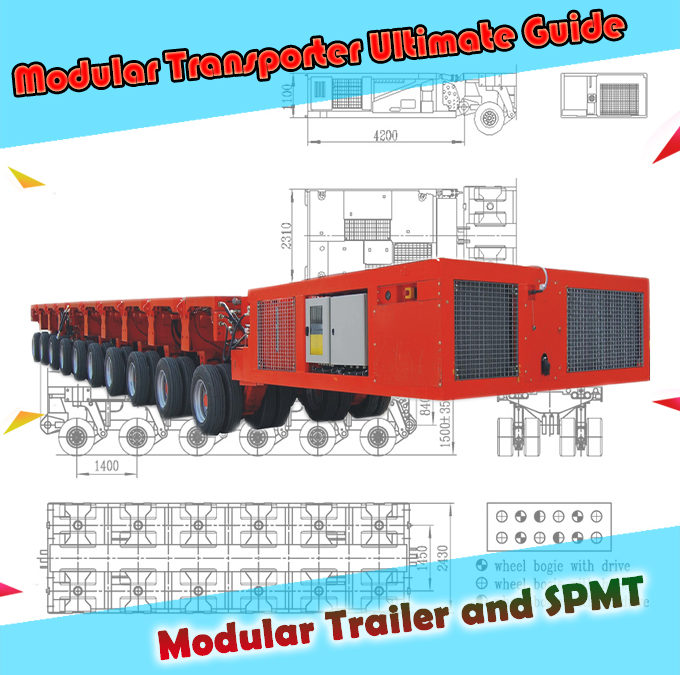
Very useful content
Informative content
Very Useful
Hello dear,
i hope you’re doing well, in fact i’m contacting you about the SPMT system informations you posted in this page.
Actually i’m studying in a school project and it’s about to move a big structure and i have no idea where i start to treat that project.
Could you please help me with?
Thank you so much